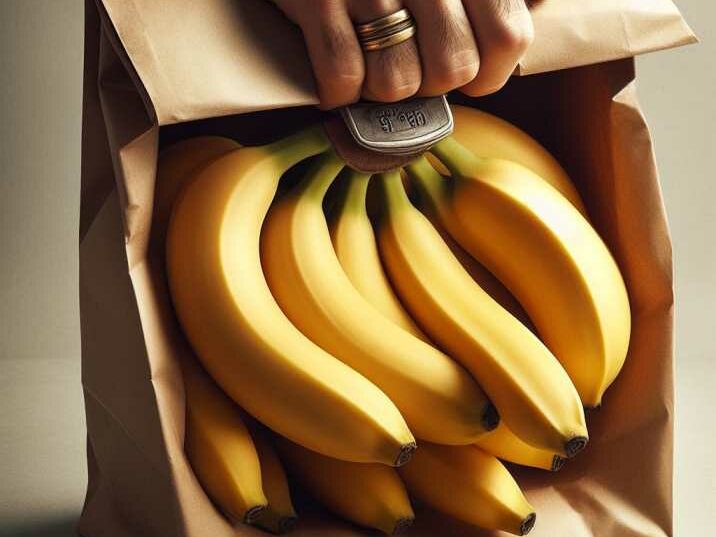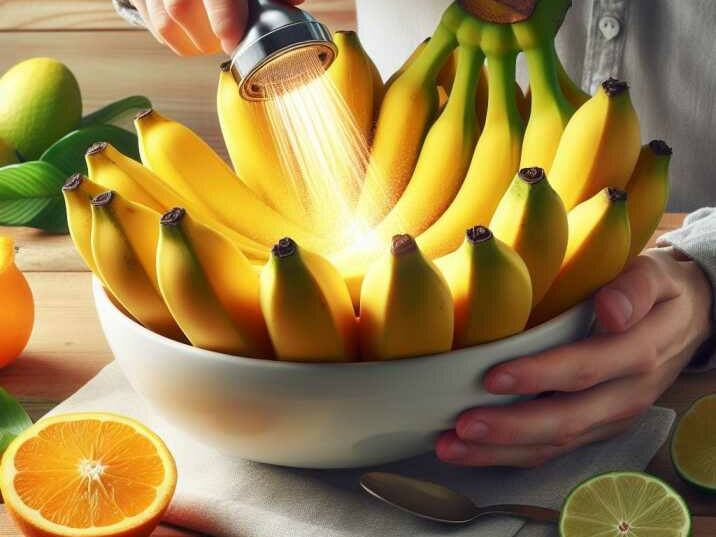Introduction
Table of Contents
Cavendish bananas are a staple in many households, prized for their sweetness and versatility in various dishes, from smoothies to desserts. However, waiting for them to ripen can often test our patience. Fortunately, several simple methods can hasten the ripening process, ensuring you can enjoy your bananas at their peak sweetness sooner rather than later. In this article, we’ll explore seven effective ways to accelerate the ripening process of Cavendish bananas at home.
Here Some Ripening Process of Cavendish Bananas at Home
Paper Bag Method
This classic method involves placing your unripe bananas in a paper bag and sealing it shut. The bananas release ethylene gas, a natural ripening agent, which gets trapped in the bag, speeding up the ripening process. For even faster results, add an apple or a ripe banana to the bag to increase the ethylene concentration.

Ripening in a Warm Environment
Bananas ripen faster in warm temperatures, so placing them in a warm spot in your kitchen can expedite the process. Avoid direct sunlight, as it may cause the bananas to ripen unevenly or develop sunburn spots. Instead, opt for a warm, well-ventilated area.
Use of Ethylene-Rich Fruits
As mentioned earlier, ethylene is a natural ripening agent. You can leverage this by placing unripe bananas alongside ethylene-rich fruits such as apples, tomatoes, or avocados. The ethylene emitted by these fruits will accelerate the ripening of your bananas.
Ripening in a Brown Paper Bag with Rice
This method combines the benefits of the paper bag technique with the moisture-absorbing properties of rice. Place your unripe bananas in a brown paper bag with a handful of rice, seal it shut, and leave it overnight. The rice helps absorb excess moisture, preventing the bananas from becoming overly ripe while still hastening the ripening process.
Use of a Ripening Bowl
Ripening bowls, also known as banana hangers or banana trees, are specially designed to accelerate the ripening process of bananas. These bowls typically have hooks or arms that suspend the bananas in the air, allowing for better air circulation and more even ripening. Simply place your unripe bananas in the ripening bowl and watch them ripen faster than if left on the countertop.

Oven Ripening
If you need ripe bananas urgently for baking or cooking purposes, you can use your oven to speed up the ripening process. Place unripe bananas on a baking sheet and bake them at a low temperature (around 300°F or 150°C) for 15-20 minutes. Keep an eye on them to prevent them from becoming too soft or overripe.
Microwave Method
This method is ideal for those who need ripe bananas within minutes. Place unpeeled bananas on a microwave-safe plate and microwave them on high for 30-second intervals until they reach the desired ripeness. Be sure to check them after each interval to prevent them from becoming too soft.
Information-Based Table
| Method | Description |
|---|---|
| Paper Bag | Place unripe bananas in a paper bag, seal it shut, and wait for them to ripen as they release ethylene gas trapped in the bag. |
| Warm Environment | Position bananas in a warm area of the kitchen, avoiding direct sunlight, to speed up the ripening process. |
| Ethylene-Rich Fruits | Place unripe bananas alongside ethylene-rich fruits like apples or avocados to expose them to ethylene gas, accelerating ripening. |
| Brown Paper Bag with Rice | Combine the paper bag method with rice to absorb excess moisture, preventing bananas from becoming overly ripe while hastening ripening. |
| Ripening Bowl | Use a ripening bowl to suspend bananas in the air for better air circulation, resulting in more even ripening compared to countertop placement. |
| Oven Ripening | Bake unripe bananas at a low temperature to expedite the ripening process, ideal for urgent baking or cooking needs. |
| Microwave Method | Microwave unpeeled bananas in short intervals until ripe, providing a quick solution for those needing ripe bananas within minutes. |
Conclusion
Ripening Cavendish bananas at home doesn’t have to be a waiting game. By utilizing these seven effective methods, you can accelerate the ripening process and enjoy perfectly ripe bananas in no time. Whether you prefer the traditional paper bag method or opt for the convenience of the microwave, there’s a technique that suits every preference and timeline.
FAQs
- Can I ripen bananas faster by refrigerating them? While refrigeration can slow down the ripening process, it won’t accelerate it. It’s best to use one of the methods mentioned in this article for faster ripening.
- Why are my bananas turning brown too quickly? Bananas turn brown due to enzymatic browning, a natural process that occurs when the fruit is exposed to air. To slow down this process, store ripe bananas in the refrigerator.
- How can I tell if a Cavendish banana is ripe? Ripe Cavendish bananas have vibrant yellow skins with a few brown speckles. They should yield slightly to gentle pressure when squeezed.
- Can I use these methods for ripening other types of bananas? Yes, these methods can be used to ripen other varieties of bananas as well, although the timing may vary slightly depending on the type of banana.
- Are there any methods to ripen bananas naturally without using other fruits? Yes, simply leaving unripe bananas on the countertop in a warm environment will naturally ripen them over time, although it may take longer compared to using ethylene-rich fruits or other methods.
